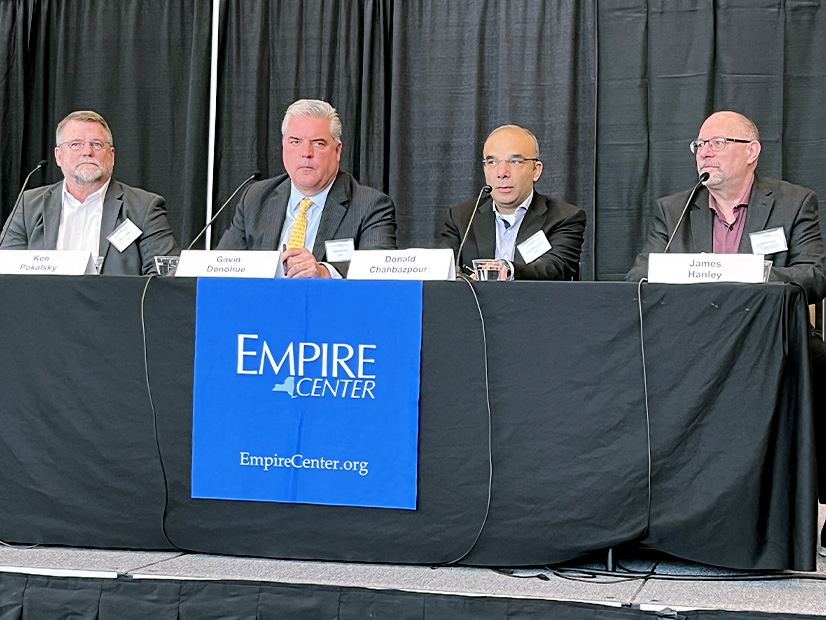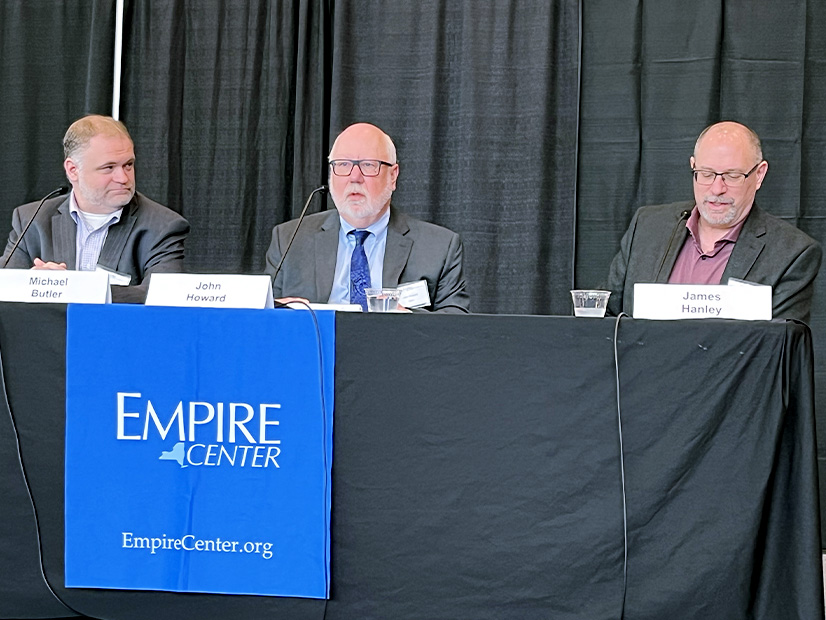
Panelists at a meeting hosted in Albany, N.Y., on Tuesday by the conservative think tank Empire Center for Public Policy questioned the pace and cost of the state’s statutory plan to move away from natural gas and electrify most home heating and transportation by 2050.
If New York’s Climate Leadership and Community Protection Act (CLCPA) is anything like other state-sponsored projects, it could cost more than $500 billion, but its benefits could total around only $200 billion by midcentury, James Hanley, senior policy analyst at the Empire Center, said in introducing a new report on perceived risks in the state’s climate action plan.
 James Hanley, Empire Center for Public Policy | © RTO Insider LLC
James Hanley, Empire Center for Public Policy | © RTO Insider LLCThe CLCPA targets 70% of the state’s electricity to come from renewable resources by 2030 and greenhouse gas emissions to be cut 85% from 1990 levels by midcentury. The law also created a Climate Action Council, which by year-end will finalize its draft scoping plan to be submitted to state lawmakers for implementation.
The All-Electric Building Act (S6843A), now in the state Senate Finance Committee, would alter the state’s Energy Conservation Construction Code to prohibit fossil fuel infrastructure and equipment in new building construction statewide no later than Dec. 31, 2023, if the building is less than seven stories, and by July 1, 2027, for all buildings.
The meeting featured representatives from business groups, state regulatory agencies, generators and utilities.
National Grid (NYSE:NGG), which operates several electric and gas utilities upstate and in New York City and Long Island, earlier this year won a state offshore wind solicitation and last month launched its own initiative to counter the state’s climate action plan.
“We can get to the same end state in a more cost-effective, pragmatic, reliable way with a high probability of success,” said Donald Chahbazpour, National Grid’s director of policy and regulatory strategy for the future of heat.
The CLCPA requires a significant buildup of the electric system, which National Grid’s clean energy plan has quantified to about 60 GW or about $70 billion in capital investments, which then translates to $1,000/year for heating customers, Chahbazpour said.
“To give you a sense of that fuller buildout … today the gas network delivers three to four times more energy on its peak day than the electric system delivers on its peak day, so if you begin to shift heating from natural gas to electricity, you may need to triple or quadruple the electric system,” he said.
There are real local pollution issues with fossil generation, particularly in downstate New York, but upstate residents are generally unaware that they will be paying 60% of the costs to clean up the air in Queens, New York Public Service Commissioner John Howard said.
“The clean energy transition is basically the recapitalization of our entire energy system. … Nobody’s ever done that, not even come close,” Howard said.
No matter what the urgency of the existential threat of climate change, reliability still comes first, he said.

“The energy capital, Houston, could tolerate 10 to 12 hours of power outage, but the real capital of the country, New York, will not — that’s not going to happen in Times Square,” Howard said.
While there is no funding mechanism in the climate law, state agencies run myriad clean energy-related programs, but it’s hard to evaluate how effective they are collectively, said Gavin Donohue, president and CEO of the Independent Power Producers of New York (IPPNY) and a member of the Climate Action Council.
“The state needs to start walking the walk as well. … Will the new Buffalo Bills stadium operate on natural gas? Is the $7 billion Penn Station renovation project compliant with the CLCPA?” Donohue said.
Business owners and managers have a hard time understanding the financial and regulatory implications behind a complicated law like the CLCPA, said Ken Pokalsky, vice president of the Business Council of New York State (BCNYS), which represents about 3,500 companies across all sectors.
“We really need to be very mindful of adopting measures that result in emissions and economic leakage from the state,” Pokalsky said. “We know that is a real phenomenon and that’s our No. 1 concern.”
Consumer costs from the environmental legislation in New York are going to be “exorbitant,” a spike that comes after the state has been leading the country by reducing emissions by 95% from 1990 to 2020, said Michael Butler, mid-Atlantic regional director for the Consumer Energy Alliance.
“I wish I had some better news, but it just looks like you’re on a path for just open costs, and those costs also are going to lead to a job flow out of the state of New York. As a Pennsylvania person, I will benefit a little bit, but I feel bad for you guys,” Butler said.

